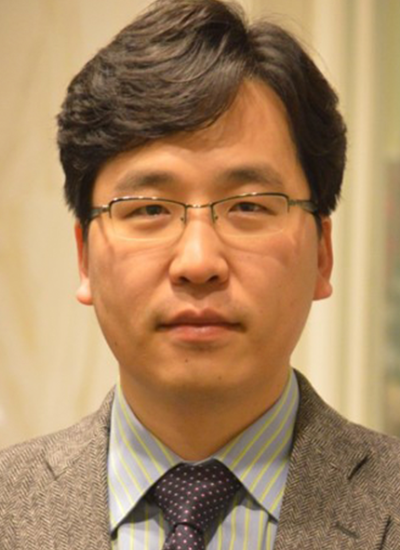Callahan, D. J., Liu, W., Li, X., Dreher, M. R., Hassouneh, W., Kim, M., Marszalek, P., & Chilkoti, A. (2012). Triple Stimulus-Responsive Polypeptide Nanoparticles That Enhance Intratumoral Spatial Distribution. NANO LETTERS, 12(4), 2165-2170.
Kim, M., Gkikas, M., Huang, A., Kang, J. W., Suthiwangcharoen, N., Nagarajan, R., & Olsen, B. D. (2014). Enhanced activity and stability of organophosphorus hydrolase via interaction with an amphiphilic polymer. Chemical communications (Cambridge, England), 50(40), 5345-8.
A simple approach to enhancing the activity and stability of organophosphorus hydrolase (OPH) is developed based on interactions between the hydrophobic poly(propylene oxide) (PPO) block of amphiphilic Pluronics and the enzyme. This strategy provides an efficient route to new formulations for decontaminating organophosphate neurotoxins.
Kim, M., Abdi, K., Lee, G., Rabbi, M., Lee, W., Yang, M., Schofield, C. J., Bennett, V., & Marszalek, P. E. (2010). Fast and forceful refolding of stretched alpha-helical solenoid proteins. Biophysical journal, 98(12), 3086-92.
Anfinsen's thermodynamic hypothesis implies that proteins can encode for stretching through reversible loss of structure. However, large in vitro extensions of proteins that occur through a progressive unfolding of their domains typically dissipate a significant amount of energy, and therefore are not thermodynamically reversible. Some coiled-coil proteins have been found to stretch nearly reversibly, although their extension is typically limited to 2.5 times their folded length. Here, we report investigations on the mechanical properties of individual molecules of ankyrin-R, beta-catenin, and clathrin, which are representative examples of over 800 predicted human proteins composed of tightly packed alpha-helical repeats (termed ANK, ARM, or HEAT repeats, respectively) that form spiral-shaped protein domains. Using atomic force spectroscopy, we find that these polypeptides possess unprecedented stretch ratios on the order of 10-15, exceeding that of other proteins studied so far, and their extension and relaxation occurs with minimal energy dissipation. Their sequence-encoded elasticity is governed by stepwise unfolding of small repeats, which upon relaxation of the stretching force rapidly and forcefully refold, minimizing the hysteresis between the stretching and relaxing parts of the cycle. Thus, we identify a new class of proteins that behave as highly reversible nanosprings that have the potential to function as mechanosensors in cells and as building blocks in springy nanostructures. Our physical view of the protein component of cells as being comprised of predominantly inextensible structural elements under tension may need revision to incorporate springs.
Lam, C. N., Kim, M., Thomas, C. S., Chang, D., Sanoja, G. E., Okwara, C. U., & Olsen, B. D. (2014). The nature of protein interactions governing globular protein-polymer block copolymer self-assembly. Biomacromolecules, 15(4), 1248-58.
The effects of protein surface potential on the self-assembly of protein-polymer block copolymers are investigated in globular proteins with controlled shape through two approaches: comparison of self-assembly of mCherry-poly(N-isopropylacrylamide) (PNIPAM) bioconjugates with structurally homologous enhanced green fluorescent protein (EGFP)-PNIPAM bioconjugates, and mutants of mCherry with altered electrostatic patchiness. Despite large changes in amino acid sequence, the temperature-concentration phase diagrams of EGFP-PNIPAM and mCherry-PNIPAM conjugates have similar phase transition concentrations. Both materials form identical phases at two different coil fractions below the PNIPAM thermal transition temperature and in the bulk. However, at temperatures above the thermoresponsive transition, mCherry conjugates form hexagonal phases at high concentrations while EGFP conjugates form a disordered micellar phase. At lower concentration, mCherry shows a two-phase region while EGFP forms homogeneous disordered micellar structures, reflecting the effect of changes in micellar stability. Conjugates of four mCherry variants with changes to their electrostatic surface patchiness also showed minimal change in phase behavior, suggesting that surface patchiness has only a small effect on the self-assembly process. Measurements of protein/polymer miscibility, second virial coefficients, and zeta potential show that these coarse-grained interactions are similar between mCherry and EGFP, indicating that coarse-grained interactions largely capture the relevant physics for soluble, monomeric globular protein-polymer conjugate self-assembly.
Kim, M., Wang, C., Benedetti, F., & Marszalek, P. E. (2012). A nanoscale force probe for gauging intermolecular interactions. Angewandte Chemie (International ed. in English), 51(8), 1903-6.


